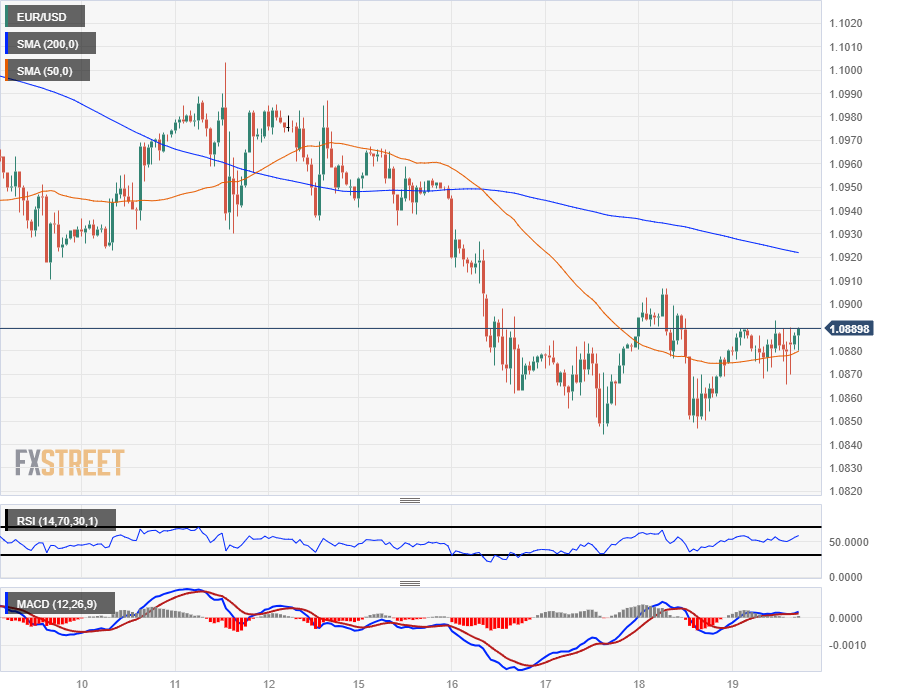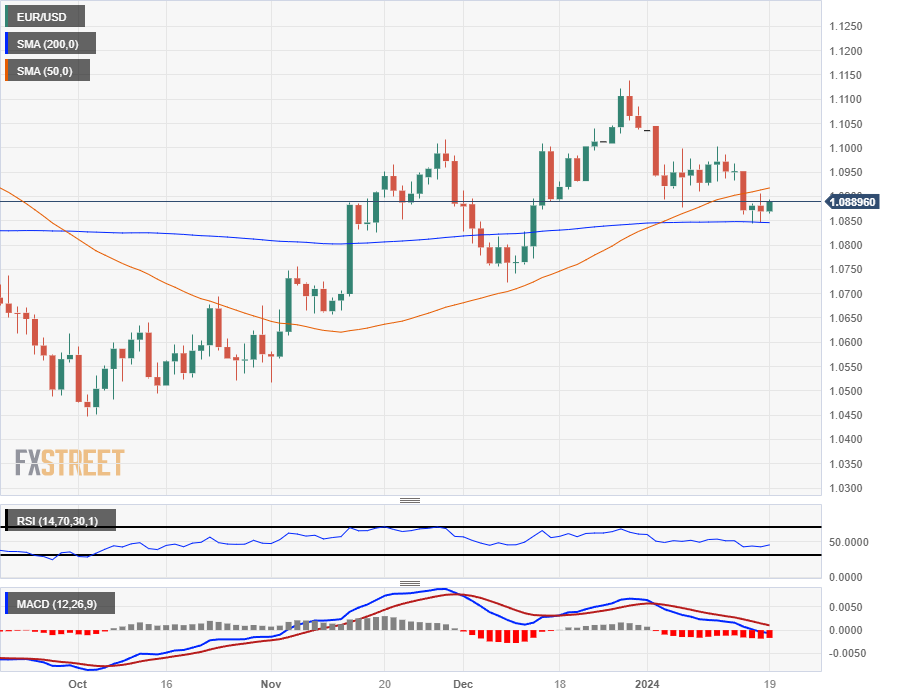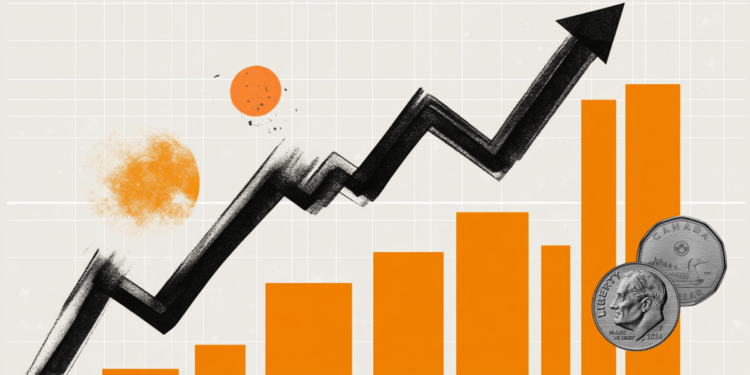- The Euro posted moderate gains on Friday ahead of the ECB lockdown.
- This week, Europe has been spared from high-profile economic data.
- Next week the latest Eurozone HCOB PMIs will be published, as well as the next ECB rate call.
The Euro (EUR) rose on Friday as market sentiment recovered on the last trading day of the week.
Last week, Europe took a break from the economic calendar as most markets focused on headlines from the World Economic Forum (WEF) in Davos, Switzerland. European Central Bank (ECB) policymakers have been working with the media to dispel market expectations of ECB rate cuts, and ECB President Christine Lagarde went to great lengths to not specifically addressing monetary policy during a series of scheduled appearances at the WEF.
Daily market summary: The Euro achieves a slight rebound on Friday
- ECB President Lagarde concluded the last of her three scheduled appearances in Davos without specifically addressing monetary policy.
- ECB officials have been in the news this week, warning that market expectations for rate cuts have gone far beyond what the ECB is willing to implement.
- Lagarde, president of the ECB, warned that overly optimistic markets will hinder the fight against inflation instead of helping it.
- The ECB could cut before the summer, but only if no new inflationary pressures appear.
- The lack of economic data from the euro zone this week has given respite to traders.
- The ECB has entered the “blackout” period ahead of next Thursday's monetary policy meeting and rate call.
- Regarding the Eurozone Purchasing Managers' Index, which will be published next Wednesday, the Markets foresee a slight rebound in the January composite PMI, which will go from 47.6 to 48.1 points.
- Next week: it is The time of the central banks
The price of the Euro today
The following table shows the percentage change of the euro (EUR) against the main currencies quoted today. The euro was the strongest currency against the pound sterling.
| USD | EUR | GBP | CAD | AUD | JPY | NZD | CHF | |
| USD | -0.11% | 0.23% | -0.18% | -0.12% | -0.05% | 0.17% | 0.13% | |
| EUR | 0.11% | 0.33% | -0.07% | -0.02% | 0.06% | 0.27% | 0.24% | |
| GBP | -0.23% | -0.33% | -0.40% | -0.37% | -0.28% | -0.06% | -0.07% | |
| CAD | 0.18% | 0.05% | 0.39% | 0.02% | 0.11% | 0.33% | 0.32% | |
| AUD | 0.14% | 0.06% | 0.40% | -0.04% | 0.09% | 0.30% | 0.27% | |
| JPY | 0.05% | -0.05% | 0.29% | -0.11% | -0.08% | 0.23% | 0.20% | |
| NZD | -0.16% | -0.27% | 0.06% | -0.33% | -0.30% | -0.21% | -0.01% | |
| CHF | -0.16% | -0.23% | 0.06% | -0.33% | -0.29% | -0.18% | 0.00% |
The heat map shows the percentage changes of the major currencies against each other. The base currency is chosen in the left column, while the quote currency is chosen in the top row. For example, if you choose the euro in the left column and scroll down the horizontal line to the Japanese yen, the percentage change in the box will represent EUR (base)/JPY (quote).
Technical Analysis: The Euro rebounds on Friday but with little momentum against the Dollar
The Euro (EUR) bounces gently on Friday and is on the rise against the major currencies, except for little progress against the US Dollar (USD) and the Canadian Dollar (CAD). Against the British Pound (GBP) and the Australian Dollar (AUD), the Euro advanced by around a third, while against the Swiss Franc (CHF) it rose by around a quarter.
The EUR/USD pair is in short-term congestion between the major moving averages. Friday's intraday action has been mostly flat, as the pair sees a slight rebound from mid-week declines to 1.0850, and the near-term price ceiling is drawn at 1.0900.
The daily candles are trapped between the 50-day and 200-day simple moving averages (SMA) at 1.0920 and 1.0850, respectively. The pair remains in technically bullish territory with a pattern of higher lows from the September lows near 1.0450. Price action sees a technical top at the January soft barrier at the 1.1000 area.
EUR/USD Hourly Chart

EUR/USD Daily Chart
Frequently asked questions about the Euro
What is the Euro?
The Euro is the currency of the 20 countries of the European Union that belong to the euro zone. It is the second most traded currency in the world, behind the US dollar. In 2022, it accounted for 31% of all foreign exchange transactions, with an average daily volume of more than $2.2 trillion per day.
EUR/USD is the most traded currency pair in the world, accounting for an estimated 30% of all transactions, followed by EUR/JPY (4%), EUR/GBP (3%) and EUR/AUD (2% ).
What is the ECB and how does it influence the Euro?
The European Central Bank (ECB), headquartered in Frankfurt, Germany, is the reserve bank of the euro zone. The ECB sets interest rates and manages monetary policy
The ECB's main mandate is to maintain price stability, which means controlling inflation or stimulating growth. Its main instrument is to raise or lower interest rates. Relatively high interest rates – or the expectation of higher rates – tend to benefit the Euro and vice versa.
The Governing Council of the ECB takes monetary policy decisions at meetings held eight times a year. Decisions are made by the heads of the eurozone's national banks and six permanent members, including ECB President Christine Lagarde.
How do inflation data influence the value of the Euro?
Eurozone inflation data, measured by the Harmonized Index of Consumer Prices (HICP), are important econometric data for the euro. If inflation rises more than expected, especially if it exceeds the 2% target set by the ECB, it is forced to raise interest rates to bring it back under control.
Relatively high interest rates compared to their peers tend to benefit the Euro, as it makes the region more attractive as a place for global investors to park their money.
How do economic data influence the value of the Euro?
Data releases measure the health of the economy and can influence the Euro. Indicators such as GDP, manufacturing and services PMIs, employment and consumer sentiment surveys can influence the direction of the single currency.
A strong economy is good for the Euro. Not only does it attract more foreign investment, but it may encourage the ECB to raise interest rates, which will directly strengthen the Euro. Conversely, if economic data is weak, the Euro is likely to fall.
The economic data for the four largest economies in the eurozone (Germany, France, Italy and Spain) are especially significant, as they represent 75% of the eurozone economy.
How does the trade balance affect the Euro?
Another important release for the euro is the trade balance. This indicator measures the difference between what a country earns from its exports and what it spends on imports during a given period.
If a country produces highly sought-after export products, its currency will appreciate due to the additional demand created by foreign buyers wishing to purchase these goods. Therefore, a positive net trade balance strengthens a currency and vice versa for a negative balance.
Source: Fx Street
I am Joshua Winder, a senior-level journalist and editor at World Stock Market. I specialize in covering news related to the stock market and economic trends. With more than 8 years of experience in this field, I have become an expert in financial reporting.







